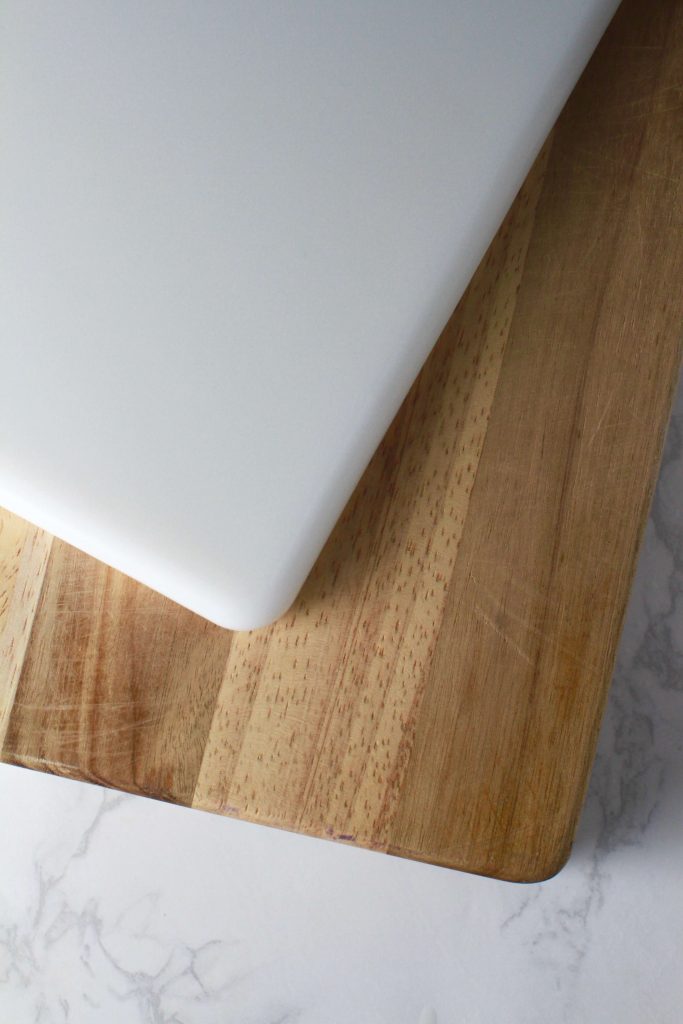Whether you cook three times a day or three times a year, you probably own a cutting board. It’s a kitchen staple with one simple job, but without it, you wouldn’t have anywhere to cut, chop, dice, or slice your meats, apples, and onions.
While you may know you need a cutting board, do you know when you should choose a wooden board over a plastic one, or vice versa? After all, anything your food touches can be a source of contamination and foodborne illness, so kitchen tools and care are no small decision.
As it turns out, there are some major differences between boards you should know before you head to the store.

Wood versus plastic
For most of history, chopping blocks then cutting boards were all made of wood. But the invention of modern plastics in 1907 meant that plastic utensils slowly began making its way into people’s homes and kitchens. The prevailing thought of the day was that plastic was easier to clean and sanitize, therefore safer.
In the late 1980s, Doctor Dean O. Cliver, a 30-year veteran of food safety science having worked for the U.S. Biological Laboratories, Food Research Institute, and University of Wisconsin’s Department of Bacteriology, decided to investigate the truthfulness of this claim. He found that plastic really wasn’t any safer. This is because wood contains antimicrobial properties that halt bacteria from multiplying on or in the board. This reduces the likelihood of cross-contamination and illness.
When to choose wood
A traditional wooden cutting board typically lasts longer than plastic cutting boards. Wood has a “self-healing” property, that means many of your cuts and scratches will be worked back into the wood. This means fewer crevices for bacteria to hide — meaning a more sanitary board. This is especially true for hard woods like bamboo and maple. Softer boards like cypress are more prone to scarring.
Another perk of wood is that your knives won’t dull as quickly since wood is kinder to your blade than plastic.
When to choose plastic
Plastic cutting boards that still have a smooth surface aren’t the problem. The concern comes after a bit of use, when scars across the board leave plenty of places for bacteria to hid and accumulate. This increases the likelihood of cross-contamination between ingredients.
Plastic boards are typically cheaper that wooden boards though, so replacing them often is more practical. Many plastic boards can also go through the dishwasher, too.
the choice isn’t clean cut
Each type of board as pros and cons. You’re good to cut whatever you want on whichever surface you like, as long as you keep your boards separate and clean. The best thing you can do is have multiple boards in your kitchen. Have one board for raw meat, fish, and poultry, and another for vegetables, fruits, and bread. Make sure ingredients stay separate, and don’t put cooked food back on the board for any reason.
cleaning a cutting board
The USDA recommends cleaning your cutting boards with hot soapy water after each use. Rinse with clear water and air or pat dry with clean paper towels.
Nonporous acrylic or plastic boards and solid woods boards can be washed in a dishwasher.
If you’re washing a cutting board by hand (recommended for wooden boards), you should:
- Rinse any debris from the board.
- Mix a solution of 1 tablespoon of unscented, liquid chlorine bleach per gallon of water.
- Flood the surface of the cutting board with the bleach solution and allow to soak for 5 to 10 minutes.
- Rinse the cutting board with clear water and air or pat dry with clean paper towels. Dry thoroughly before putting them away.
When to replace your board
All cutting boards, no matter the material, wear out over time. Once grooves become excessive and hard to clean, boards should be thrown out.
Also see, Which leaves dishes cleaner: a dishwasher or washing dishes by hand?




